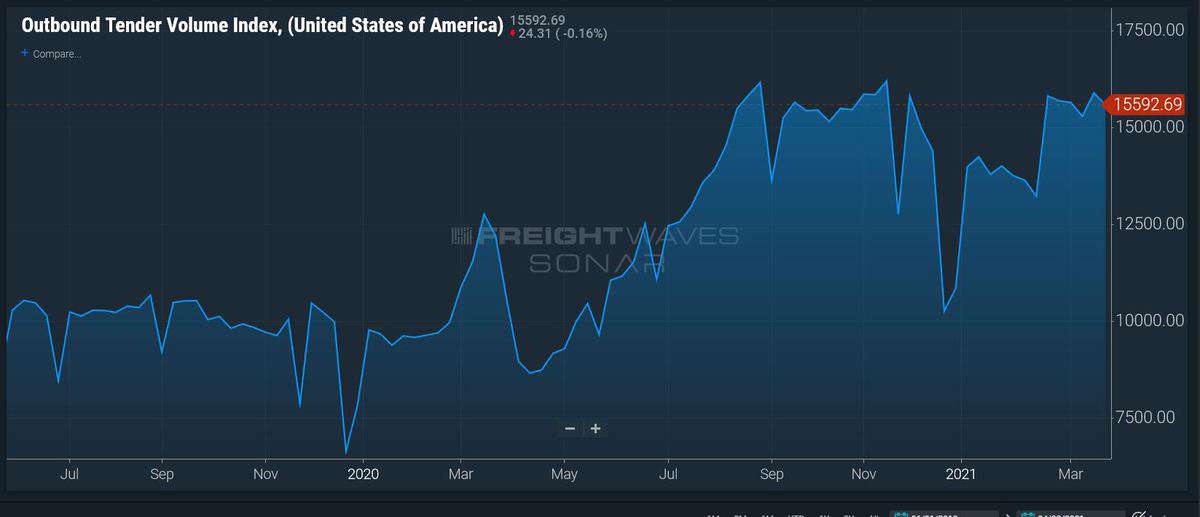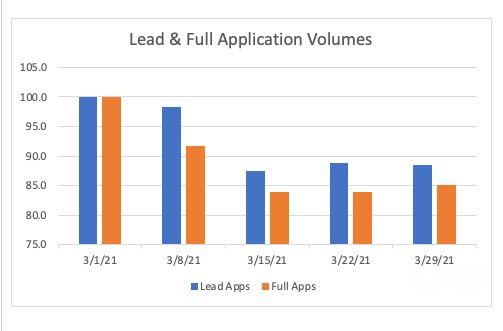In the midst of one of the strongest freight markets in years, there are still fewer workers employed in the truck transportation sector than a year ago.
But this may be the last month for a while that statement can be made. Year-on-year comparisons from this point on will be looking at months in 2020 that were in the full grip of the pandemic.
The employment report for March 2020 had already begun to show the impact of the COVID-19 pandemic, with employment figures for the truck transportation sector that month 8,600 jobs less than that of February 2020. The following month, the April 2020 report showed a whopping decline of 87,800 jobs from March, at 1,428,400 jobs.
The basic numbers for employment in truck transport and warehouses can be found in FreightWaves’ earlier story. The growth in jobs reported for the month was viewed by Jason Miller, associate professor of logistics at Michigan State University, as positive. “The seasonally adjusted gain of 3,300 jobs in March from February is a very good sign because (i) the February figures were revised up substantially (2,300 jobs) and (ii) this figure doesn’t include the additional 4,500 jobs that are normal seasonality,” Miller told FreightWaves in an email. “The actual number of jobs created for employees is in fact 7,800.”
Comparing the 1,482,700 jobs in the truck transportation sector for March this year to last year still is relevant, because March 2020 had not yet taken a full blown hit from the pandemic. But moving forward, it may take several months for year-on-year comparisons to make any difference, because it isn’t clear just when employment numbers will be considered “post-pandemic” and when they can be compared to the latest monthly update and actually mean something.
For now, the reality is that the March 2021 number was 33,500 fewer truck transportation jobs than a year ago, even though in March 2020, the economy was starting to feel the blow from the pandemic.
Even more striking, the March figures are 50,000 jobs less than the record month of July 2019. That was a year plenty of people in the trucking sector will tell you was mostly miserable for carriers. For example, the FreightWaves outbound tender volume index (OTVI), which measures freight volumes, closed June 2019 at about 8,450. The most recent reading is more than 15,500. Yet there are fewer workers in the truck transportation sector.

The question is why. And a source of significant debate in the trucking industry is just what impact expanded unemployment and stimulus funds are having on the willingness of people to become truck drivers or stay out on the road if they’re already behind the wheel.
Aaron Terrazas of Convoy, in an email to FreightWaves, said the overall employment statistics have “one number that still keeps me up at night. The labor force participation rate barely budged.”
The number Terrazas is referring to is the national average. As he said, “It’s still stuck at 61.5%.”
That figure is “roughly where it’s been since the fall and is down nearly 2 percentage points from precrisis levels,” Terrazas said. That translated into a reduction of approximately 4 million people who are working or looking for work.
“The key question to ask ourselves right now is: When, if ever, will these people return to the labor market?” he said in his email. “The answer will hold a clue as to when labor force participation might rebound and, critically, when we’ll start to see labor market slack put a brake on wage growth.”
Beyond the question of stimulus money is the question of whether child care responsibilities are keeping people at home, since some children not back at school but learning from home need supervision.
Terrazas is skeptical. He said he has looked for a relationship between labor force participation and the reopening of schools and can’t find a correlation. “If child care was weighing on participation, you’d expect to see one,” he said in his email.
He was more emphatic about unemployment insurance. “If unemployment insurance is playing a role in keeping workers on the sidelines of the labor market — as the business community often suggests — it would contradict three decades of research on the relationship between UI and labor market participation,” Terrazas wrote.
But there are other voices. For example, Tim Crawford, the co-founder and CEO of Tenstreet, which among other things helps the application process for drivers and fleets, told FreightWaves in an email that the numbers support the idea that government checks are slowing the flow of people getting seated in trucks.
“We saw in March a huge drop in both lead and full applications, week over week,” he said. “While it’s hard to directly attribute the drop to any one factor, we typically don’t see this type of massive and sudden drop in volume without an external cause like the stimulus. Anecdotally, we’ve been hearing from clients that many candidates that were in process prior to the stimulus checks starting to arrive are declining to move forward in the hiring process.”

Among some of the other highlights in the report:
- The gig economy is soaring, if it’s assumed that the employment levels of couriers and messengers are indicative of strength in that market. That category rose 16.7% in just one month, to 1,088,900 jobs. A year ago, it was 893,700 jobs.
- Economists generally look at seasonally adjusted figures. But the not seasonally adjusted numbers are also important. They showed non-seasonally adjusted jobs in the truck transportation sector at 1,461,300 in March, versus a seasonally adjusted number of 1,482,700, a difference of more than 21,000 jobs. That number also was up significantly compared to the February figure of 1,461,300 jobs.
- The relatively flat seasonally adjusted numbers for warehouse employment were not mirrored in the not-seasonally adjusted figures, where a decline in employment was reported. Jobs there dropped to 1,411,700 from 1,416,300 jobs. The decline is striking mostly in comparison to the strong growth rates, where not-seasonally adjusted jobs a year ago stood at 1,337,800.
- One number in the report that can’t help be looked at with some skepticism is the figure on pay. Despite publicly announced pay increases and figures on soaring per-mile rates for moving freight, the BLS reported that hourly wages for production and nonsupervisory employees in the truck and transportation sector were $24.61 per hour, down from $25.01 in January. For all workers including supervisory employees, it was a decline to $26.60 from $26.89. The numbers are not just for drivers, but drivers are in there and appear to fly against all other reports on rising pay in the trucking industry.
- Rail jobs continued their relentless decline, coming in at 140,700 jobs, down from 141,600 jobs a month earlier. A year ago, that seasonally adjusted number was 158,300 jobs. Six years ago, it was 209,700 jobs.
More articles by John Kingston
Truck transportation jobs grow but still below year-ago levels
California’s Prop 22 spurred by AB5 finds early victims: grocery delivery drivers
Did employment of truckers drop just because they can’t be found?







